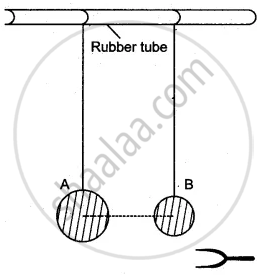Advertisements
Advertisements
प्रश्न
Explain free and forced vibrations. Give an experimental arrangement to illustrate the phenomenon of resonance.
उत्तर
When a system or a body vibrates without receiving impulses from another system or body, its vibrations are said to be free vibrations. However, when a system or body vibrates on account of impulses received from another system or body, the vibrations are called forced vibrations. In such a case the body or the system vibrates with the frequency of the impulses received and not with its natural frequency.

Experiment Arrangement to illustrate Resonance: In the figure, the two pendulums have exactly equal lengths. However, the bob of the pendulum A is heavier. Displace the bob of the pendulum A by a little distance in a direction perpendicular to the plane containing the two pendulums. Then release the bob. The pendulum A will begin to oscillate. After a short while, you will find that the pendulum B also begins to vibrate. Note that the two pendulums have the same frequency. The pendulum A through the rubber tube applies impulses of the same frequency on the pendulum B Hence, the pendulum B begins to vibrate.
APPEARS IN
संबंधित प्रश्न
Give one example to illustrate forced vibrations.
(i) Define resonant vibrations.
(ii) Which characteristic of sound, makes it possible to recognize a person by his voice without seeing him?
Two pendulums C and D are suspended from a wire as shown in the figure give below. Pendulum C is made to oscullate by displaying it from its mean position. It is seen that D also starts oscillating.

(i) Name the type of oscillation, C will execute.
(ii) Name the type of oscillation, D will execute.
(iii) If the length of D is made equal to C then what difference will you notice in the oscillations of D ?
(iv) What is the name of the phenomenon when the length of D is made equal to C ?
The diagram below shows three different modes of vibration P, Q and R of the same string of a given length.
 |
 |
 |
| P | Q | R |
- Which vibration will produce a louder sound and why?
- Which vibration will produce sound of maximum shrillness (or pitch) and why?
- What is the ratio of wavelength of vibrations P and R?
A bucket kept under a running tap is getting filled with water. A person sitting at a distance is able to get an idea when the bucket is about to be filled.
(i) What change takes place in the sound to give this idea?
(ii) What causes the change in the sound?
Explain why stringed musical instruments, like the guitar, are provided with a hollow box.
State two ways in which resonance differs from forced vibrations.
The rearview mirror of a motorbike starts vibrating violently at some particular speed of the motorbike. What is the name of the phenomenon taking place? Why does the happen?
Explain a person walking past a railway line, in the middle of night hears a ringing sound along with the sound of his footsteps.
